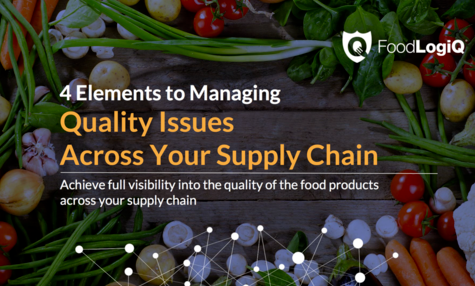Quality incidents… the phrase probably makes you cringe, doesn’t it? No restaurant or business in the food and beverage industry is eager to think about compromised food quality and the negative effects that come with it; including sick customers, bad press, brand damage, fines, penalties, and recalls.
But the fact remains that such incidents do happen, even when you have what you think are the best preventive methods in place. The vital part is how you respond.
The Challenges of Incident Management
Incident management is a simple label for a massive responsibility. Incidents, large and small, occur multiple times each day. Some are food-related and others are non-food-related.
Food-related incidents include contamination of raw food, allergens, packaging defects, chemical residues, consumer illness outbreaks, and supply-chain issues. Some non-food-related incidents include natural disasters, a worker shortage, and plant accidents.
So incidents can be traced back to any number of sources. This, in and of itself, constitutes a major challenge.
In order for an organization to prevent potential incidents and reduce risks, the supply chain, quality assurance department, legal department, managers, food prep employees, cooks, and anyone else who has had any sort of contact with food, must be involved. When time is of the essence, this can be a huge problem.
Then you have to consider the fact that, in an increasingly global supply chain, incidents often originate from outside your organization. “Yet, the organization must respond and prevent the incident from becoming a crisis for its own business,” explains Bizhan Pourkomailian, Ph.D., in Food Safety Magazine.
“Naturally, there also are cases where the incident is the direct result of action taken by the organization. In either case, whether the organization is directly or indirectly involved, the incident must be managed.”
Thus, incident management is as much about preparedness as it is about the response. It’s best to look at it as a circular process that can feed on itself over and over again.
The World Food Programme does a good job of explaining how their process works. It follows the process of initiating, detecting, estimating, acting, learning, and then initiating and repeating again.
Curious about some of the key elements to managing quality issues in your supply chain? Download our fact sheet below:
Five Reasons to Pursue Modernization
Clearly, there are many challenges associated with incident management. It requires time, resources, and a concerted effort from everyone involved to master this all-important task.
This is where modernization enters the picture. If you can modernize incident management, you’re able to improve results without increasing the number of person-hours it takes to get the job done. After your initial setup of workflows and process, you’ll save time on every incident report.
Over the last few years, the ability to use software platforms for incident management has become easier and more practical, thanks to food incident management apps and food incident management platforms. Here are a few benefits to using these technologies:
Save Time and Money
When there’s an incident, time is always of the essence. The quicker you can respond, the more likely you’ll be able to contain or isolate an issue before it becomes a major problem with far-reaching consequences. The real-time nature of food incident management platforms is one of the biggest reasons food-service operations have migrated to this technology in droves.
Centralize Data
Food companies operate in a business universe in which mobile devices, fragmented apps, and individual programs lead to data sprawl. The problem is most companies don’t recognize how decentralized their data has become until a problem occurs. When you have a food incident management app, you can consolidate and centralize this data and regain control over your supply chain whether you’re in the office or on the move.
Enhance Communication
Communication is of crucial importance in incident management. Everyone in your organization (and really, the entire supply chain) needs to be included in the conversation. With manual incident management, this is nearly impossible. If anything, it demands hours and hours of additional time.
With a platform, it’s much simpler. Everyone has access to the same information, and communication occurs in a systematic and streamlined manner.
Improve Prevention and Resolution Processes
Another wonderful thing about food incident reporting technology is that you can improve both prevention and resolution. Though prevention is obviously the most preferred strategy, it also helps to have a system that allows you to respond in a fraction of the time when an incident forces its way onto your to-do list.
Not All Food Incident Management Platforms are Created Equal
There are a lot of food incident automation apps and systems on the market. But not every system is effective.
A platform needs to streamline investigations, cut the time needed to submit credit requests, and produce a documentation trail (online, of course!) that can be exported if necessary. That's where the FoodLogiQ Connect platform comes in:
-
Know the number/scope of quality incidents per supplier at a quick-glance
-
Recoup the cost of nonconforming product directly from your supply chain partners
-
Track customized communication between the customer and supply chain partner surrounding quality issues
Other posts you might be interested in
View All Posts
Quality Management
12 min read
| October 1, 2021
The Art of Selection: Choosing the Right Quality Incident Management Solution
Read More
Supplier Compliance
8 min read
| May 31, 2018
In Wake of Romaine Lettuce Recall, FoodLogiQ Shares Thoughts on the Importance of Supply Chain Management and Food Traceability
Read More
Food Industry
8 min read
| June 29, 2023


